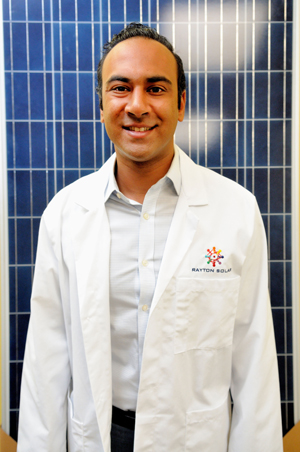Solar panel prices might be at an all-time low, but Santa Monica startup Rayton Solar is hoping to drive them even further down.
Rayton Chief Executive Andrew Yakub claims to have invented a more efficient method for cutting silicon wafers for solar panels using a proton beam rather than a wire diamond saw. The patented technology, said Yakub, allows the firm to manufacture solar panels with up to 100 times less silicon than traditional methods and at a price of 23 cents a watt. That’s compared with the roughly 65 cents a watt that traditional manufacturers spend to make panels, according to data from SPV Market Research, which represents a cost savings of about 65 percent.
“If (Rayton Solar) can drive down manufacturing costs into the 20 (cents a watt) range that’s a significant game-changer,” said Kevin Smith, chief executive of Santa Monica’s Solar Reserve, a solar power plant developer and operator. “That manufacturing process would then become the leading edge on cost.”
Rayton, backed by nearly $3 million in venture capital from a group of undisclosed angel investors, is also testing the waters on a potential $7 million Regulation A+ offering that would be raised through Santa Monica’s StartEngine, which launched an equity crowdfunding platform last year.
Rayton Solar has attracted $3.1 million in reserved shares from more than 1,100 individuals on the platform since it started tested the waters in July. Ron Miller, StartEngine’s chief executive, said Rayton’s product has the potential to generate enthusiasm from environmentally conscious investors who understand the pain of high electric bills and the global warming implications of dirty energy sources.
“What we really emphasized was not the importance for them to talk about the product or the company but why the world is going to be better because of Rayton Solar,” he said. “The reason people get excited is because they believe that Rayton will change the world by significantly reducing the cost of solar and improving efficiencies.”
The global solar panel market, driven in large part by hefty government subsidies around the world, particularly in China, was estimated at $24 billion last year and is expected to hit $180 billion in 2021, according to market researcher Radiant Insights Inc. However, the global market has had problems with oversupply, which has driven down costs – and manufacturer profits.
Pavel Molchanov, a Houston-based energy analyst for Raymond James & Associates Inc., said numerous solar panel manufacturers through the years have had very aggressive cost targets.
“Some have succeeded but most have not,” he said.
Tipping scale
Producing low-cost solar panels at scale will also be a challenge, said Fred Walti, chief executive of downtown’s Los Angeles Cleantech Incubator.
“There’s always a challenge in going from labs and pilots to manufacturing-scale deployment. I’ve seen a lot of companies struggle,” he said. “It’s only until you start putting a manufacturing process together that you understand what the costs are and if you really can do it.”
Still, Yakub is confident Rayton Solar’s manufacturing process can live up to its promise.
“We’ve done it and made it work in a lab setting,” said Yakub. “Now, with the pilot program it will prove that it can work in a commercial setting; that it can be scaled up.”
That will take time – and lots of money – said Paula Mints, chief market research analyst at SPV Market Research in San Jose, noting solar companies face high hurdles.
“You need a lot of money to put a product through labs scale, through pilot scale, through commercialization. It will take at least a decade,” she said. “By the time they are in production, the market will have changed. It takes great courage to persevere in this industry.”
Beam me up
Yakub entered the solar panel industry in 2009 when, with his father, he co-founded ReGen America Inc. of Valencia, a commercial rooftop solar panel financier, installer, and operator. He later went on to work at UCLA’s Particle Beam Physics Lab as a design engineer where he came up with the idea to use a particle accelerator to cut silicon solar panels.
Yakub recruited several of his physics professors to pursue the idea as a business and raised $2.8 million in seed capital from several undisclosed investors. The company launched in 2013 and has six full-time employees.
“I had a choice about a year ago,” explained Yakub. “Do we go the professional (venture capital) route or do we try out this new equity crowdfunding thing? I decided on crowdfunding,” he said, noting that marketing surrounding a small initial public offering could also help drum up customer interest.
Another challenge for him is figuring out how to go to market. After the company completes its pilot manufacturing run, he said the firm will explore several options including licensing its technology, manufacturing panels for installers, or selling panels directly to consumers.
In addition to cheaper products, Yakub claimed Rayton would also be able to produce silicon wafers that are 25 percent more energy efficient in terms of the amount of sunlight that’s converted into electricity. To spread the word about this technology, Rayton has recruited TV host and scientist Bill Nye as its paid pitchman.
Getting Nye to sign on as the company’s promoter wasn’t easy, said Yakub, who recalled a three-hour meeting at the firm’s headquarters.
“He highly scrutinized our technology,” said Yakub. “It was crazy because I grew up watching him in elementary school and here I was having to explain our technology to him.”

